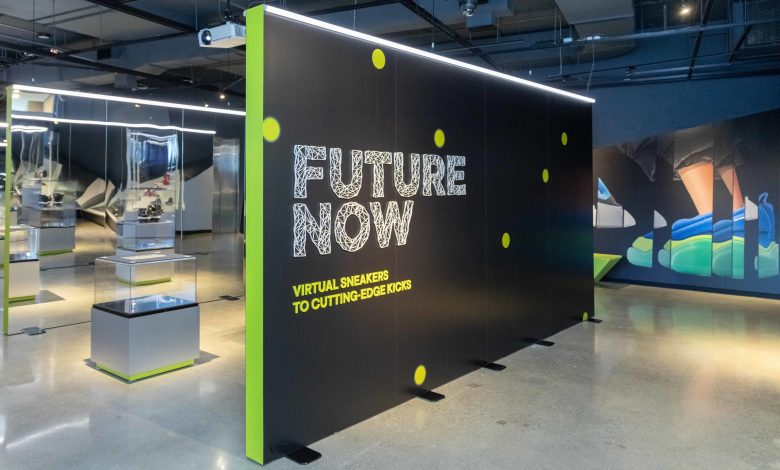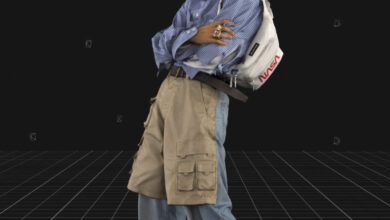Sci-fi Sneaker Design is the Future

[ad_1]
We spoke to sneaker expert Elizabeth Semmelhack about new cutting-edge footwear. Plus, a roundup of our favourite kicks on the market.
There’s a scene in the original Jumanji movie where a young Alan Parrish (Robin Williams) visits his dad’s factory, The Parrish Shoe Company. One of the workers, Carl, pulls him aside to reveal his latest creation: what appears to be a replica of the Air Max 2 Nike Charles Barkelys. “This is the future,” he says. “If I can get Wilt Chamberlain to wear them, I predict there will be a pair of these in every closet in America.” Alan then mistakenly destroys the shoes, a rather large piece of equipment, and Carl’s career.
That was 1995. In the years leading up to that moment, some of today’s most sought-after sneakers were hitting the shelves (and closets) of America and beyond. (The Nike Air Jordan 1 OG Breds, released in 1985, are valued at some US$94,000 today — and that’s just the lowest asking price, per DealA.)
We may never know the resale value of Carl’s fictional shoe, but it’s safe to say he had the right marketing strategy. Whether the kicks did indeed represent the future of sneaker design is up for debate.
No longer a practical construction of canvas and rubber, sneakers have come a long way since their invention in the 19th century. Today, manufacturers are sourcing nature-based materials like mushroom leather and sugarcane foam. New technologies like 3:D printing are being used to create bespoke and accessible sneaker design. And designers are now dabbling with footwear’s final frontier: the metaverse.
These innovations are the focus of a new exhibition at Toronto’s Bata Shoe Museum, called “Future Now: Virtual Sneakers to Cutting-Edge Kicks.” Some highlights include the Nike MAG self-lacing sneakers, a biomorphic boot by Scry designer Zixiong Wei and Ekto VR’s motorized boots for wear by VR users.
FASHION spoke to Elizabeth Semmelhack, director and senior curator of the museum, about the history of sneaker design, what the future holds and how shoe construction could affect the resale market.
What are some of the most interesting or promising sustainability-focused materials or techniques in sneaker design right now?
I think that some of the most promising new materials are nature-based. Allbirds’ sweet foam, an EVA foam replacement made from sugarcane, is being used for the soles of their shoes and the company has made the “recipe” open source rather than proprietary to encourage sustainability. Mushroom leather is also an exciting new material that is very environmentally friendly. Using the root systems of mushrooms, breathable, leather-like material can be easily grown and used to make footwear. After use, it can also be sustainably discarded.
How do you expect the materials being used to make shoes will evolve?
I think we will move toward more bespoke design, meaning that consumers will be able to get shoes that more perfectly fit their unique feet and more perfectly align with their individual aesthetics. I also think that 3:D printing will increasingly be used to make remarkable designs. Scry, for example, is using this technology to make truly sci-fi-looking footwear.
The resale market for (certain) sneakers is booming! Why do you think this is?
I actually find this very interesting. The term “investment” originally meant “to clothe” and so sneakers as an asset class makes perfect sense. We have long been encouraged to buy “investment” pieces for our wardrobes but only recently are some of these items seeing actual monetary returns.
How do you see that appetite evolving?
This is perhaps a bit more challenging to foretell. Currently, much of the value of resale sneakers is related to their rarity but also to their history; a pair of original 1985 Air Jordan 1s is a perfect example. However, most sneakers from the 1970s onward are extremely fragile. The materials they were made from are deteriorating, impacting not only their resale value but also our ability to preserve them for the future. We are working on trying to solve this problem at the museum as so many of the sneakers in our collection are important cultural objects.
What’s the value in a virtual sneaker, by comparison?
The value of virtual sneakers has been growing exponentially, market corrections aside. Certainly some virtual sneakers can be worn by one’s avatar in the metaverse as a virtual flex, but their real value is specifically as collectibles or investments.
What role will the metaverse play in the future of sneakers?
If you consider the Jordan drops in Fortnite, Nike’s acquisition of RTFKT and their creation of Nikeland or Adidas’s foray into the metaverse, it appears that sneakers have a central role to play in the metaverse. What I am even more excited to see is how footwear design will evolve in virtual reality. Given that footwear isn’t required in virtual spaces — there is no practical reason for shoes in VR — the possibilities for footwear design are endless.
Is accessibility and inclusivity becoming a more important part of shoe production?
Yes, both are increasingly being addressed by brands. The Nike Go Flyease is a perfect example of universal design that meets the needs of a range of wearers. It is designed to be easily slipped on and off and is also highly desirable as an item of fashion. The move toward unisex sizing is another shift that allows for greater inclusion.
What’s something few people know about the history of sneaker production?
That when sneakers were first created in the middle of the 19th century, rubber was extremely expensive, and that the first sneakers were made for lawn tennis, a pastime of the privileged. I think that many people marvel at how important sneakers are today as signifiers of status but I feel like they have simply come full circle.
Swipe through the gallery below to shop FASHION‘s favourite kicks that represent the future of sneaker design.
[ad_2]
Source link






